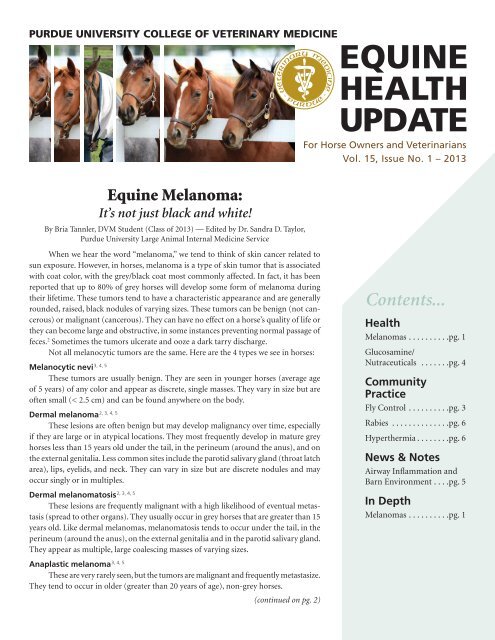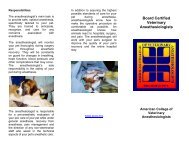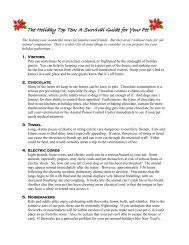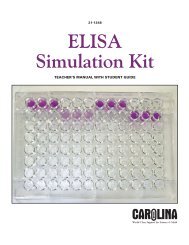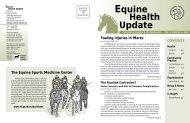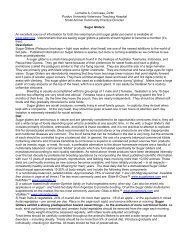EQUINE HEALTH UPDATE - Purdue University School of Veterinary ...
EQUINE HEALTH UPDATE - Purdue University School of Veterinary ...
EQUINE HEALTH UPDATE - Purdue University School of Veterinary ...
You also want an ePaper? Increase the reach of your titles
YUMPU automatically turns print PDFs into web optimized ePapers that Google loves.
Melanoma (continued from cover)2Melanoma can sometimes occur onthe eyelid. The best way to know ifa nodule is cancerous is to have itexamined by your veterinarian andto send an aspirate or biopsy out tothe lab for further evaluation.(Source: http://www.chron<strong>of</strong>horse.com)How can you tell if a mass is malignantor has metastasized?It is important that your veterinarian examine any massfound on your horse. Diagnostic tests can be done to clarify whatthe mass is, and include a fine needle aspirate (obtaining cells witha needle), biopsy, or even complete removal for evaluation <strong>of</strong> cellsand tissue under a microscope.A rectal examination or ultrasonography can help locateinternal masses that may be indicative <strong>of</strong> metastasis. The mostcommon sites for metastasis include the lymph nodes, spleen, liver,lining <strong>of</strong> the abdominal wall, lungs and blood vessels. 2How should melanocytic nevi, melanomas andmelanomatosis be treated?Surgical ExcisionEarly treatment <strong>of</strong> small tumors is ideal to prevent them fromspreading to the surrounding tissues. In fact, excision <strong>of</strong> melanocyticnevi and benign dermal melanomas can be completely curative. 5Research within the last 10 years has shown that excision <strong>of</strong>large masses with a scalpel and/or carbon dioxide (CO2) laser hasbeen effective; masses did not recur during the 2 year follow-upperiod in any <strong>of</strong> the cases that were studied. 5, 6Intralesional CisplatinCisplatin is a chemotherapeutic (cancer-treating) drug that is<strong>of</strong>ten used along with surgical excision in order to kill <strong>of</strong>f anyleft-over tumor cells.Injections <strong>of</strong> cisplatin into the tumor itself and the shorttermimplantation <strong>of</strong> slow release cisplatin-containing beadshave shown efficacy in tumor resolution both with and withoutsurgical excision for at least 2 years. 1, 5CimetidineAlthough most tumors do not respond to the immune system’sattempt to get rid <strong>of</strong> them, some melanomas can get smaller whenunder immune attack. Cimetidine is a histamine blocker that canpreserve the body’s immune response and allow tumor cell killing.Cimetidine has reduced tumor growth and halted tumorprogression in 3 horses with melanoma, but has not proven to beefficacious in complete tumor resolution. 4Melanoma VaccineCurrently, a vaccine exists for canine melanoma that has showngood efficacy. 7 A similar vaccine has been created for equinemelanoma and is currently being studied at the <strong>University</strong> <strong>of</strong>Florida’s College <strong>of</strong> <strong>Veterinary</strong> Medicine. If you would like to findout more about this study please visit http://research.vetmed.ufl.edu/clinical-trials/large-animal/vaccine-study-for-gray-horseswith-melanoma/What should you do for your horse?Treating equine melanoma is not black and white. Althoughmelanoma is thought to be slow growing, the incidence <strong>of</strong>eventual malignancy is high. Early surgical and or chemotherapeutictreatment <strong>of</strong> melanocytic nevi, dermal melanoma or evenmelanomatosis may be beneficial in slowing down or stoppingthe progression <strong>of</strong> the disease. Research to produce more effectivetreatment protocols is ongoing.Often, melanoma is diagnosed in its later stages when treatmentis unlikely to have any effect. “Right now we need to raise thebar so that equine practitioners and the general public understandthat melanoma is a malignancy and not a benign thing, like amole,” says Michael Porter, DVM, Ph.D. Dipl. ACVIM. “Increasedsurveillance, diagnosis and treatment could reduce the numbers<strong>of</strong> horses presented with non-treatable lesions.” 8Ultimately, if you notice a black noduleor mass on yourhorse or feel something abnormal under the skin, seek promptveterinary care and be sure to ask your veterinarian about newadvances in treatment.References1. Hewes CW, Sullins KE. Use <strong>of</strong> cisplatin-containing biodegradable beadsfor treatment <strong>of</strong> cutaneous neoplasia in equidae: 59 cases(2000-2004).J Am Vet Med Assoc. 2006; 229:1617-1622.2. MacGillivray KC, Sweeney RW, Del Piero F. Metastatic Melanoma in Horses.J Vet Intern Med. 2002; 16:452-456.3. Valentine, BA. Equine Melanocytic Tumors: A Retrospective Study <strong>of</strong> 53 Horses(1988-1991). J Vet Intern Med. 1995: 9(5): 291-297.4. Goetz TE, Ogilvie GK, Keegan KG, Johnson PJ. Cimetidine for treatment <strong>of</strong>melanomas in three horses. J Am Vet Med Assoc. 1990 Feb 1;196(3):449-52.5. Rowe EL, Sullins KE. Excision as treatment <strong>of</strong> dermal melanomatosis in horses:11 cases (1994-2000). J Am Vet Med Assoc. 2004; 225; 94-96.6. Theon, AP, Wilson WD, et.al. Long-term outcome associated with intratumoralchemotherapy with cisplatin for cutaneous tumors in equidae:573 cases(1995-2004). J Am Vet Med Assoc. 2007; 230(10):1506-1513.7. Bergman PJ, Camps-Palau MA, McKnight JA, et al. Development <strong>of</strong> axenogeneic DNA vaccine program for canine malignant melanoma at theAnimal Medical Center. Vaccine 2006;24(21):4582–58. Kane, E. Incidences <strong>of</strong> Neoplasia. DVM 360. 2006. http://veterinarynews.dvm360.com/dvm/article/articleDetail.jsp?id=325543&sk=&date=&pageID=2Small lumps below the ear in thearea <strong>of</strong> the throat latch may not benoticed as easily and the characteristicblack appearance <strong>of</strong> the massmay not be noticeable from theexternal hair coat.(Source: http://www.acvs.org/AnimalOwners/HealthConditions/LargeAnimalEquineTopics/SkinTumorsInHorses/index.cfm?dspPrintReady=Y)The area under thetail and around theanus are common sitesfor melanomas andmelanomatosis.(Source: http://www.chron<strong>of</strong>horse.com)
Fly Control (continued from pg. 3)Feed-through products are also available, such asEquitrol® II Feed-Thru Fly Control, also by Farnam Companies,Inc. These products are designed to be fed to your horseso that the chemicals are present in their manure, resulting infatal toxicity to developing fly maggots. There is some concernabout the toxicity <strong>of</strong> these products, particularly when fed topregnant mares as the active ingredient is an organophosphate,albeit in a small amount.There are available alternatives to pesticides as well,including a number <strong>of</strong> pesticide-free sprays. Other fly controlmethods include biological insecticides, such as BTI and FlyPredators. BTI is a naturally occurring soil bacterium thatcan be added to pond water to kill mosquito larvae withoutharming other animals. Mosquito-eating species <strong>of</strong> fish, suchas killifish and mosquit<strong>of</strong>ish, can also be added to pond water.Fly Predators reduce pest fly populations by destroying thenext generation <strong>of</strong> flies in their immature pupa (cocoon) stage.They never become pests themselves and are small, biteless andstingless. They live their entire life-cycle on the fecal pile andeat the pest fly pupa.Other Preventative ManagementConsult your veterinarian for regular deworming andvaccination regimens in the Spring and Fall each year. Vaccinesare available to prevent EEE, WEE, and WNV. Dewormers thatcontain ingredients such as ivermectin and moxidectin canprevent many parasites that can be transmitted by flies. Thereis no known method <strong>of</strong> fly control that <strong>of</strong>fers 100% eradication<strong>of</strong> pesky flies. While we may not be able to control fliesentirely, we can control the parasites and viruses they spreadwith preventative medicine.For More InformationYou can access the <strong>Purdue</strong> Extension Entomology websitefor more information on insect control: http://extension.entm.purdue.edu/Mosquitoes may be harder to notice on your horse dueto their smaller size. They breed in aquatic environments,such as stagnant pools or puddles <strong>of</strong> water.Sources:Camp, Joseph. <strong>Veterinary</strong> Parasitology II. <strong>Purdue</strong> <strong>University</strong>,College <strong>of</strong> <strong>Veterinary</strong> Medicine. Spring 2011.Foil, Lane and Carol Foil. “Fly Control”. Current therapy in equine medicine.Editor: Robinson. Edition 5. St. Louis, MO: Saunders Elsevier, 2005.Townsend, Lee. “Insect Control for Horses, Horse Barns, and Stables”.<strong>University</strong> <strong>of</strong> Kentucky Extension Service, College <strong>of</strong> Agriculture. 2011News & NotesAirway Inflammationand the Barn EnvironmentHorses frequently develop inflammationin the lung, with mucus buildupand airway narrowing increasingthe effort <strong>of</strong> breathing. At its mostsevere, this inflammation results inrecurrent airway obstruction (RAO),a disease commonly referred to asheaves. Heaves usually affects olderhorses and can cause coughing andsuch severe difficulty breathing thataffected horses lose weight from theeffort. Mild airway inflammation that causes more subtlesigns can occur in horses <strong>of</strong> all ages and is known as inflammatoryairway disease (IAD). Because the disease reducesthe efficiency <strong>of</strong> oxygen movement from the lung into theblood, the effects <strong>of</strong> IAD become noticeable when horsesare asked to perform athletically.Heaves and IAD are believed to develop as a result<strong>of</strong> the dust that horses breathe when they are keptin barns, but the exact cause <strong>of</strong> disease is unknown.A study conducted at <strong>Purdue</strong> followed a group <strong>of</strong> youngThoroughbreds over the course <strong>of</strong> their first month in training,measuring the amount <strong>of</strong> airway inflammation and thelevels <strong>of</strong> dust for each horse. The majority <strong>of</strong> these younghorses were found to have airway inflammation consistentwith IAD. In these horses, a specific inflammatory white bloodcell involved in allergic reactions, the eosinophil, increasedin the lung when high levels <strong>of</strong> dust were measured. Thisfinding provides the evidence that IAD may develop as anallergy to components <strong>of</strong> the dust in the barn. This study alsoshowed that the level <strong>of</strong> dust exposure can be reducedby feeding hay from the ground rather than elevatedin a hay-net.To explore the components <strong>of</strong> dust that cause the immunesystem <strong>of</strong> the lung to react, a new technique was developedto separate the proteins in barn dust and determine if theyare recognized by antibodies in the lung and if differentproteins are recognized by horses with airway disease suchas heaves and IAD. This method revealed that there are manyproteins in airborne barn dust that are recognized by lungantibodies, and that there appear to be differences in thenumber and type <strong>of</strong> proteins recognized by individual horses.The results suggest that certain proteins in barn dustmay be important factors in triggering inflammationin the airway <strong>of</strong> the horse.Research will continue at <strong>Purdue</strong> <strong>University</strong> College <strong>of</strong> <strong>Veterinary</strong>Medicine to learn more about the interaction betweenthe barn environment and the immune system <strong>of</strong> the equinelung with the hopes <strong>of</strong> providing new diagnostic tests andnew treatments for airway disease in the horse.— Dr. Katy Ivester, DVM, PhD, DACVS5
Rabies and Horses: What’s the Risk?By Mark A. Yoder, DVM Student (Class <strong>of</strong> 2013)Edited by Dr. Stacy H. Tinkler, <strong>Purdue</strong> Equine Community PracticeIf you have ever wondered: “Can horses get rabies?”, “What arethe signs <strong>of</strong> rabies?”, “How is rabies spread between animals?”,or “Is my horse at risk and how can I prevent rabies?”, thenkeep reading!What is rabies?Rabies is a viral disease that can infect all mammals and resultsin neurologic disease—disease <strong>of</strong> the brain and spinalcord—that causes your horse to move or behave abnormally.There are a few different ways that rabies can be transmittedbetween animals and to humans, but the most common isthrough bite wounds <strong>of</strong> infected animals. Once an animal orhuman is exposed, the virus multiplies in the muscle aroundthe site <strong>of</strong> the bite wound. Eventually the virus travels up theperipheral nerves (outer nerves in extremities) and gets into thecentral nervous system (brain; spinal cord). Finally, the viruswill move from the central nervous system to various tissuesin the body; most importantly the salivary glands. This makesit possible for the virus to then be passed on to other animalsthrough the saliva via bite wounds.Top 7 Pointers for PreventingHyperthermia in Your Horse this SummerBy Dr. Janice Kritchevsky, Large Animal Internal Medicine Service, <strong>Purdue</strong> <strong>University</strong>IntroductionMany horse owners think summeris the best time <strong>of</strong> year. The showand fair season is in full swing, andit’s the best time for camping, trailriding, and many <strong>of</strong> the other activitiesthat make owning a horse sucha pleasure. Like humans, horses cool <strong>of</strong>f by producing sweat and byincreasing their respiratory rate. If the horse becomes so hot thatsweat and increased respiration cannot cool it down, hyperthermiaresults. Body temperatures above 105.8ºF can cause life threateningdamage to the body’s cells unless cooled <strong>of</strong>f quickly. Below are somethings to consider before hitting the trails this summer. If you have anyquestions about your own horse, be sure to contact your veterinarian.1. Know the difference between hyperthermia and a feverA fever is an increase in body temperature that occurs when the brainincreases the thermal set point, <strong>of</strong>ten in response to an infection orinflammation. Hyperthermia is an increase in body temperature thatoccurs because <strong>of</strong> an increase in heat from external sources. Usuallythe horse is otherwise healthy. While there is a maximal increase inits own temperature that a horse can reach due to fever, there is nomaximum with hyperthermia. This is why hyperthermia is so muchmore dangerous than fever.2. Know if your horse is at riskHorses that are older, debilitated, suffering from an illness,or have just moved to a hot climate from a cooler place areat increased risk <strong>of</strong> developing hyperthermia. Fans, shade, andfresh water should be available to horses at increased risk <strong>of</strong> hyperthermiaat all times.3. Access to fresh waterWhen a horse becomes dehydrated, blood supply to the skin is shutdown so that blood flow to vital organs is preserved. In addition, lesssweat can be produced. Both situations hinder a horse’s ability to coolitself <strong>of</strong>f. Horses will drink more water in the summer to compensatefor losses in the sweat; sometimes doubling their intake from that inthe winter. It is important that their increased water needs are metby having fresh, potable water available.4. Access to electrolytesIn addition to water, horse sweat has high concentrations <strong>of</strong> electrolytessuch as sodium, chloride, and calcium. Like water, it mustbe replaced for the horses to be able to cool <strong>of</strong>f. Electrolytes can be<strong>of</strong>fered to the horse in the form <strong>of</strong> a balanced complete diet, or assupplemental electrolytes that can be fed alone or added to water.If electrolyte water is <strong>of</strong>fered, always <strong>of</strong>fer fresh water as well.5. Trailers can become hot boxesLike a car with its windows rolled up, a closed up trailer becomesextremely hot when standing in the hot sun. If a horse must be keptin a trailer for any period <strong>of</strong> time, make sure that there is adequateventilation by opening windows and vents.6. Do not overworkMuscles generate heat when they are exercised, and a gallopinghorse must dissipate a large amount <strong>of</strong> muscle heat. This is moredifficult for a horse as the ambient temperature increases. Graduallyincrease the amount <strong>of</strong> exercise asked <strong>of</strong> a horse so that its body canadapt. During the very hottest days <strong>of</strong> summer, reserve hard trainingtimes to the cooler times <strong>of</strong> the day. Watch for signs <strong>of</strong> overheating,and do not continue with a horse that feels hot to the touch, stopssweating, or has an increased respiratory rate after stopping.7. Recognize anhydrosisAnhydrosis is the inability to sweat. A horse that cannot sweat has lostits best cooling mechanism, and is at very high risk <strong>of</strong> hyperthermia.A horse with anhydrosis will feel hot and dry to the touch, and willnot sweat when hot. To compensate, the respiratory rate increasesdramatically and <strong>of</strong>ten a horse with anhydrosis is believed to havepneumonia or some other respiratory disease. A horse that cannotsweat must be kept in a shaded, cool spot with good ventilation untila veterinarian has been able to examine the horse.
<strong>EQUINE</strong> <strong>HEALTH</strong> <strong>UPDATE</strong>is published by:<strong>Purdue</strong> <strong>University</strong>College <strong>of</strong> <strong>Veterinary</strong> MedicineEquine Sports Medicine Center1248 Lynn HallWest Lafayette, Indiana 47907-1248ADDRESS SERVICE REQUESTEDPhone: 765-494-8548Fax: 765-496-2641www.vet.purdue.edu/esmc/Nonpr<strong>of</strong>it Org.U.S. PostagePAID<strong>Purdue</strong> <strong>University</strong>With generous support <strong>of</strong><strong>Purdue</strong> <strong>University</strong>’s <strong>Veterinary</strong>Teaching Hospital and the College <strong>of</strong><strong>Veterinary</strong> Medicine Dean’s Office.Please address all correspondence relatedto this newsletter to the address above.Editorial Board:Drs. Couétil L., Hawkins J. and Tinkler S.Design & layout by:Elaine Scott DesignEA/EOUTheEquine Sports Medicine Center<strong>Purdue</strong>’s Equine Sports Medicine Center is dedicated to the educationand support <strong>of</strong> Indiana horsemen and veterinarians through thestudy <strong>of</strong> the equine athlete. The Center <strong>of</strong>fers comprehensive evaluationsdesigned to diagnose and treat the causes <strong>of</strong> poor performance,to provide performance and fitness assessments, and to improve therehabilitation <strong>of</strong> athletic horses. Other integral goals <strong>of</strong> the Centerare to pioneer leading-edge research in the area <strong>of</strong> equine sports medicine, toprovide the highest level <strong>of</strong> training to future equine veterinarians, and to <strong>of</strong>ferquality continuing education to Indiana veterinarians and horsemen. For moreinformation visit our website:www.vet.purdue.edu/esmc/Continuum© by Larry Anderson


